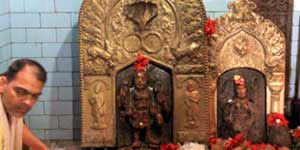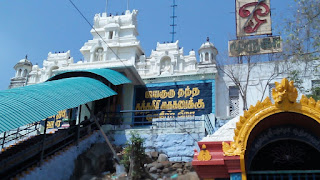Kakkassery Bhattadri – A Saint from Kerala.
Kakkasseri Bhattadiri was a great saint who lived in Kerala in the 17th century. At that time, the areas around Kozhikode was ruled by Zamorin kings (Samoothripad). Annually, there used to be a debate on Vedas,Puranas,Theology and Ithihasas headed by the king. It was caled as Pattathaanam which extended for a period of 7 days. It started on the Malayalam month of Thula on the Revathy star and hence it was called Revathy Pattathaanam. Pattathaanams were held regularly till Tipu Sulthan’s invasion of Malabar. But the last Pattathaanam was held in 1110 Malayalam year (1934 AD).Most of the time, debates used to be conducted in the Tali Shiva Temple , which even today is managed by trustees from the Zamorin family.
The winners were rewarded in cash and kind, plus the fame of having won the debate in the Zamorin’s Court. Namboothris from all over Kerala would assemble at Kozhikode for the intellectual contest.The subjects were divided into 108 topics and debates used to be conducted on each of them.
Once a Tamil Brahmin by name of Uddhanda Sastri came to take part in this contest from Thondai Nadu (Present day Kanchipuram/Chennai region). Vainglorious, while he entered the court he would recite the following couplet:
Palaayadhwam palaayadhwam, re re dushkavi kunjara|
vedaanta vanasanchaaree, hyayaathyuddanda kesari.||
Run and hide, run and hide, ye elephants of bad poetry|
The roamer of vedanta forest, uddhanda, the Lion is coming.||
He won over the debates with the Namboothris for several years in a row. The king was so pleased with the knowledge of this Scholar, he appointed him as his Chief Courtier. In those days the Scholars were held in high esteem and as a mark of respect, the Zamorin would prostrate before the scholars in the presence of assemblage. This irked the Namboodthris no end and they conspired to defeat Uddhanda Sastri. Unfortunately, none in their group had the knowledge to equal the Sastri and defeat him in a fair contest.
Birth
They decided to invoke spiritual blessings to defeat Shastri.They identified a pregnant woman,masterminded a course of austerity and spiritual disciplines, sitting around her and making her the incumbent of the spiritual grace. Selected chants and invocations were made. Havans were performed. The expectant woman took her part in all this by partaking of the Yajna prasada every day. Specifically, they invoked Bala Tripurasundari of Sri Vidhya tradition, who is considered as deity which blesses one with abundant power of speech. They would perform Japa and give the sanctified butter to the woman. Finally a son was born – Kakkassery Bhattathiri
When he was three years old, his father died. As part of the tradition, one of the rituals for the departed involved making rice balls and invoking the departed ancestors. The belief is that the ancestors will take the form of crows and eat it. Normally the crows come down and eat the rice balls completing their part of the ritual. This is done for over a period of days, where the crows are invoked to have the rice balls. It is said that Bhattathiri used to identify each crow from other and could tell, which crow came the previous day and which didn’t. Due to his remarkable power of observation, which became evident with identification crows, he was called Kakkasseri. ” Kaakka ” meaning crow in Malayalam.
He learnt to read and write by 3 years. When he was 5 years, he started to acquire the knowledge of vedas. He grew up revealing exceptional notes of intelligence right from very early age.Legend are that he was trained by none other than the great Uddanda shastri himself. The boy had hardly grown up to be an adult when the same Uddanda Sastri was held by him in a direct debate arranged by the elderly folk.
Debates with Uddana Shastri
During the first debates, Shastri in his colourful and commanding attire saw his opponent, not more than a boy. he declared that as it is only a small boy he will not argue with the boy, but his parrot will. Saying this, he brought out his parrot. Equally smiling Kakkasery brought out a cat he has brought saying that his cat will talk to the parrot. Seeing the cat the parrot got frightened and hid itself in the cage.
In another debate, at the Zamorin’s Court, when the boy entered:
“Aakaro hraswa:”
accosted the Sastri, seeing the puny boy, which would mean that you are “short in stature”.
“Nahi, nahiaakaro deerkha:”, was the instantaneous retort, “Akaro hraswa:”
No, (the letter) ‘aa’ is long ; ‘a’ is short.
Sastri was dumbfounded by this quick repartee, even before the start of the debate, because it implied that the acclaimed scholar did not even know the basic alphabets.
Then came another.”Tava mata pativrataa ?” (Meaning – Is your mother a devoted wife to your father? ).It was considered impossible to answer this question without impugning the honour of one’s mother.But the boy was neither embarrassed nor worried. He boldly contradicted it, thus revealing his profound knowledge of Vedic marriage rites.In all South Indian Marriages, the twentyfifth Vedic ritual is Agni or holy fire ritual. This mantra from the Rg Veda is recited by the groom after doing prostrations to the fire.
“Nahi,Nahi,” he said, “Soma was her first , Gandharva, the next, Agni, the third and the one born of man (his father) was the fourth (Rig. Veda Vill, iii, 27.5)
“You (the bride) was taken care by Soma (the moon) in the beginning . The Gandharva had take care of you afterwards from him. Then the Gandharva gave you to Agni. That Agni is now giving you to me along with wealth. After being taken care by all these Gods, I am the first human being to have her. So because Soma, Gandharva and Agni have already given her wealth and capacity to have children, me and this woman will have all the good fortunes in this world.” The mantra must not be directly interpreted. The symbolism is that God takes care of our need through these deities right from our birth and we need to be thankful to them. Uddhanda Shastri was thrilled and hugged the young scholar in joy.
The debates ran for 7 days. During the debate, the king tries to save Uddanda by saying the debate was a tie and proposed another debate for the next day with the context – whoever gives the maximum number of explanations of the first stanza of Kalidasa’s Raghuvamsamsa would win the debate. Uddanda shastri was an expert in Raghuvamsamsa and the king thought he would suitably win. But when Uddanda shastri gave 4 explanations, Kakkashery gave 8.
On the final day he is acknowledged by one and all including the King himself. There have been several debates later also between Uddanda shastri and Kakkasseri, but Kakkasseri wins all of them. In the meanwhile, Kakkassery also wrote a sankrit play vasumathi-manavikrama about the king and his family.
Later Years and self Realization
During the later days of his life, Kakkassery stopped going to temple( Mookuthala Bhagavathy temple in Mallapuram district) or even perform the nithyakarmas.
“How am I to worship the sandya?” Kakkassery questioned the Namboodris, who asked him for the reason for non performing the Sandya.
“Hridakase chidaditya:
sadabhati niramaayam,
Udayasthamanow nastha
katham sandyam upasmahey?”
“The sun does’t rise or set in my heart. When the cosmic consciousness shines in my heart througout, with no rising or setting, how am I to worship sandya?’
It was said that he led a nomadic and spiritual life travelling from place to place. He is used to make the annual visit at the Thali temple for the regular Pattathanam. On one such occasion, he advised the gathered Brahmins and scholars to worship the Bhagavathi (Devi) at the time of distress. Taking his advice, the gathered Brahmins conducted an intense yagnja for 41 days to please the Devi. On the 41st day, Kakkassery visited the temple and asked for drinking water. After having the water, he left, and nobody has ever seen him again. So, there are no records of his later years.
Location: Kozhikode, Kerala 673001, India

